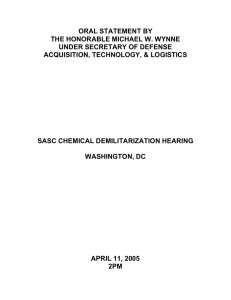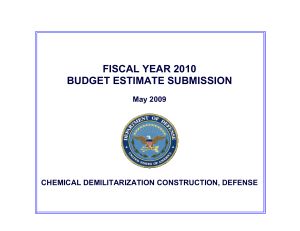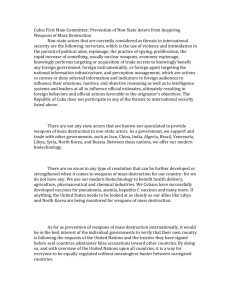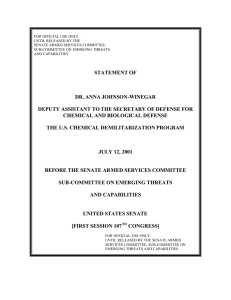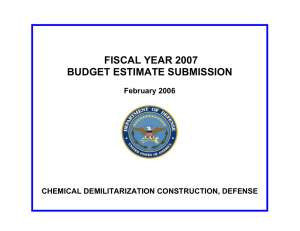STATEMENT OF THE HONORABLE DALE KLEIN
advertisement
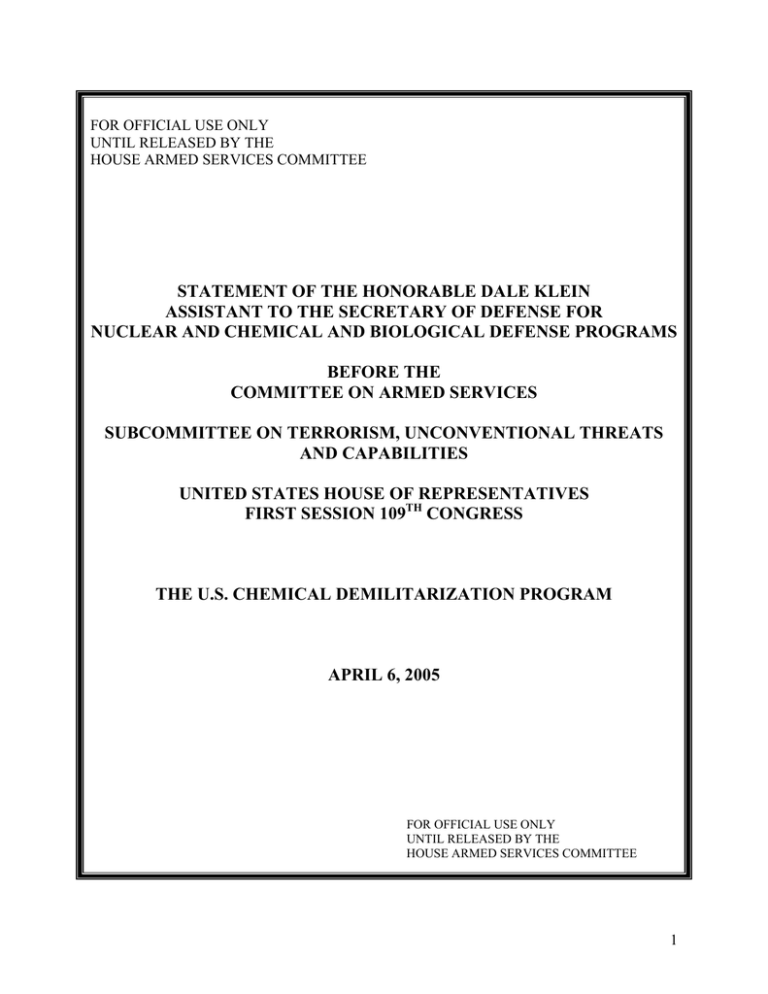
FOR OFFICIAL USE ONLY UNTIL RELEASED BY THE HOUSE ARMED SERVICES COMMITTEE STATEMENT OF THE HONORABLE DALE KLEIN ASSISTANT TO THE SECRETARY OF DEFENSE FOR NUCLEAR AND CHEMICAL AND BIOLOGICAL DEFENSE PROGRAMS BEFORE THE COMMITTEE ON ARMED SERVICES SUBCOMMITTEE ON TERRORISM, UNCONVENTIONAL THREATS AND CAPABILITIES UNITED STATES HOUSE OF REPRESENTATIVES FIRST SESSION 109TH CONGRESS THE U.S. CHEMICAL DEMILITARIZATION PROGRAM APRIL 6, 2005 FOR OFFICIAL USE ONLY UNTIL RELEASED BY THE HOUSE ARMED SERVICES COMMITTEE 1 I am Dr. Dale Klein, the Assistant to the Secretary of Defense for Nuclear and Chemical and Biological Defense Programs. As I previously testified, in my current capacity, I am the principal advisor to the Secretary and Deputy Secretary of Defense and the Under Secretary of Defense for Acquisition, Technology and Logistics, for all matters concerning the formulation of policy and plans for nuclear, chemical, and biological programs, and, most important to our topic of discussion today, chemical weapons demilitarization. Today, I will discuss three major points: 1) the current status of the DoD Chemical Demilitarization Program and its positive safety record; 2) the importance of fully funding the Fiscal Year 2006 President’s Budget request, which has been submitted in compliance with Public Law 107-314, Section 141a; and 3) the directives of the recent Acquisition Decision Memorandum (ADM). First, I want to emphasize my commitment to safety as the paramount consideration in the Chemical Demilitarization Program. I have championed this cause vigorously during the past four years while focusing on destroying our aging stocks of chemical weapons. As the Chemical Demilitarization Program moves forward, the Department will balance resources to maximize the amount of chemical weapons destroyed while protecting our workers, the surrounding public, and the environment. Second, I want to emphasize and respectfully request that you fully fund the Fiscal Year 2006 President’s Budget. This budget request funds existing and future chemical weapons destruction efforts. As of December 31, 2004, the U.S. destroyed more chemical agent in accordance with the Chemical Weapons Convention than all other state parties combined. By May 2005, the Department expects to be operating six chemical weapons destruction sites, and the U.S. remains on track to meet the Chemical Weapons Convention extended 45% destruction deadline of December 31, 2007. The U.S. continues to be a leader in the international community regarding the destruction of chemical weapons, and now, more than ever, each and every dollar requested directly supports destroying our aging chemical weapons stockpile and maintaining our commitments as outlined by the Chemical Weapons Convention. Third, I will discuss the Department’s recent efforts to implement the ADM that was signed on December 21, 2004. We have learned since 1986, when Congress mandated the destruction of our chemical weapons stockpile, that there are many unanticipated challenges associated with a national program of this magnitude. By May 2005, the Chemical 2 Demilitarization Program expects to be simultaneously destroying different chemical agents in various configurations at six separate sites, 24 hours a day, seven days a week, and in four time zones, using different technologies and employing different contractors. The ADM provides guidance for meeting these continuing challenges while destroying our chemical weapons stockpile in a safe, cost effective, and timely manner. Program Status and Safety Record The Chemical Demilitarization Program is composed of two primary programs, the Chemical Materials Agency (CMA) under the Secretary of the Army; and Assembled Chemical Weapons Alternatives Program (ACWA) under the Secretary of Defense. Currently, four of the CMA chemical weapons destruction sites are operational, the incinerators at Anniston, Alabama, Tooele, Utah and Umatilla, Oregon, and neutralization facility at Aberdeen, Maryland. The Department expects to begin operations by May 2005 at the other two CMA sites, the incinerator at Pine Bluff, Arkansas, and the neutralization facility at Newport, Indiana. The Pine Bluff, Arkansas facility is completing the State permitting process, and the Newport, Indiana facility is determining a method for treating hydrolysate, which is a product of operations. To that end, the Newport, Indiana facility is completing National Environmental Policy Act requirements and will provide Congressional notification prior to the start of destruction operations as mandated by 50 U.S.C. Section 1512. The ACWA Program sites at Blue Grass, Kentucky and Pueblo, Colorado are in the design stages of development. While this is a summary of the overall status of the facilities, the Department can provide you a more detailed account on a site-by-site basis if desired. While engaged in the important and challenging task of destroying these chemical weapons, the Chemical Demilitarization Program fully succeeded in protecting the surrounding public and the environment during the past year. For example, in February 2005, the Governor of Alabama presented the Anniston Chemical Demilitarization Facility’s operating contractor with an Award of Superior Achievement for two years of safe, continuous operation. Similarly, in January 2005, the Umatilla Chemical Demilitarization Facility’s contractor received a 2005 Oregon Governor’s Occupational Safety and Health Award. The program will continue to build on this success and maintain safety as the top priority. 3 FY 2006 Budget Summary The funds requested for the Chemical Demilitarization Program in the Fiscal Year 2006 President’s Budget are necessary for destroying the U.S. chemical weapons stockpile as mandated by Public Law 99-145 and the Chemical Weapons Convention. These funds will allow the Department to continue chemical weapons destruction operations at Anniston, Alabama, Tooele, Utah, and Umatilla, Oregon, continue ton container cleanout operations at Aberdeen, Maryland, and begin operations at Newport, Indiana and Pine Bluff, Arkansas during 2005. The Department plans for all of these sites to be operational during 2005. The Department is also in the process of evaluating alternatives that will allow the ACWA Program sites at Blue Grass, Kentucky and Pueblo, Colorado to remain within their budgets, balance cost, schedule, and performance, and meet program objectives. The budget request also maintains Chemical Stockpile Emergency Preparedness Program activities at all the chemical weapons stockpile sites. The Fiscal Year 2006 President’s Budget reflects these funding priorities. Acquisition Decision Memorandum (ADM) Since I testified before this committee last year, the Chemical Demilitarization Program has experienced unanticipated technical challenges resulting in increased funding requirements. In November 2004, the Acting Under Secretary of Defense for Acquisition, Technology, and Logistics (Acting USD(AT&L)) convened a meeting of the Defense Acquisition Board (DAB) to review the entire Chemical Demilitarization Program. Based on the advice and counsel of the DAB, the Acting USD(AT&L) signed an Acquisition Decision Memorandum (ADM) on December 21, 2004 that included three major directives. First, the Acting USD(AT&L) divided the Chemical Demilitarization Program into three Major Defense Acquisition Programs (MDAPs) as follows: 1) the ACWA, which includes the Blue Grass, Kentucky and Pueblo, Colorado sites; 2) the Newport, Indiana neutralization facility; and 3) the CMA, which includes the remaining five destruction facilities, non-stockpile chemical materiel product, and Chemical Stockpile Emergency Preparedness Program. The Program Manager ACWA (PM ACWA) is responsible for the ACWA MDAP, and the Director of CMA is responsible for both the Newport and CMA MDAPs. Second, the Acting USD(AT&L) directed that funding be prioritized to maximize the destruction of chemical weapons and meet our intermediate Chemical Weapons Convention 4 obligation of destroying 45% of our stockpile by December 2007. As noted above, the CMA includes the six sites that are operating or will begin operating during 2005. Maintaining operations at all existing destruction sites will allow the U.S. to comply with the Chemical Weapons Convention extended 45% deadline of December 31, 2007. The ACWA Program funding will be used to incorporate lessons learned from the Aberdeen and Newport sites into the emerging designs for the Blue Grass, Kentucky and Pueblo, Colorado sites. Third, the Acting USD(AT&L) directed the PM ACWA and CMA to develop alternatives that are safe, cost effective, and achieve the Chemical Weapons Convention extended 100% destruction deadline of April 2012 within existing resources. The potential alternatives may include the following: consolidating the stockpile by transportation; redefining requirements in terms of cost, schedule, and performance; seeking competition for future work; and modifying contracts and contract incentives. The Department understands that any alternative must comply with statutory authority, but all alternatives are being considered at this point. Further, evaluation of potential alternatives may well result in the continuation of our current efforts, but, at a minimum, it gives us the opportunity to ascertain the costs and benefits. Therefore, these analyses help manage and fulfill the Department’s obligation of responsible resource management to the U.S. taxpayer. The Department expects to complete this evaluation by April 2005, and I ask for your support as we evaluate all alternatives that enable the continued safe, cost effective, and timely destruction of our chemical weapons. As a first step to improve cost management, the Acting USD(AT&L) has directed the PM ACWA to modify existing contracts to better balance cost, schedule, and performance, and to redesign the facilities to stay within budgets. The complete evaluation of design alternatives for the destruction of the chemical weapons stockpiles at the Blue Grass, Kentucky and Pueblo, Colorado sites is expected to be complete by the end of Fiscal Year 2005. A plan for implementation of the selected alternative will be developed at that time. Our efforts to exercise fiscal responsibility within the Chemical Demilitarization Program have never been intended to delay the destruction of chemical agents at Blue Grass or Pueblo. While we agree with citizens and elected officials alike that it is important to begin destruction efforts at Blue Grass and Pueblo, we also agree that any facility we design, construct, and operate must be safe, environmentally protective, timely, and cost effective, as required by the Congressional mandate that created the ACWA Program. If we do not manage fiscal resources, 5 the projected life-cycle cost to destroy the U.S. chemical weapons stockpile could grow from $26.8 billion in 2004 to as much as $40.2 billion in 2012, based on historical data (see Attachment 1). The Cost Analysis Improvement Group (CAIG) also provided a similar estimate. Therefore, the Department is evaluating alternatives to ensure that the program conforms to reasonable cost and schedule guidelines as it moves forward. The directives contained in the ADM provide sound guidance for continuing the safe destruction of the chemical weapons stockpile and meeting our obligations under the Chemical Weapons Convention. Final Remarks In conclusion, I would like to reiterate three important points. First, safety is our top priority, and the Department will continue to protect its employees, the public, and the environment, while destroying our aging chemical weapons stockpile. Second, funding of the Fiscal Year 2006 President’s Budget request is needed to maintain this important program. Third, the Department needs your support as we implement the Acquisition Decision Memorandum and provide the best value to the taxpayers. Finally, I want to emphasize the Department’s commitment to this prominent national security program of destroying our nation’s chemical weapons safely and expeditiously. Eliminating targets of opportunity for terrorists such as these deadly chemical agents is essential. We face many unique challenges, but we are continuing our efforts to meet our statutory requirements and obligations under the Chemical Weapons Convention. I welcome your comments on our program’s progress, and I look forward to working with you to advance our common goal of the safe and complete destruction of our national chemical weapons stockpile. 6
